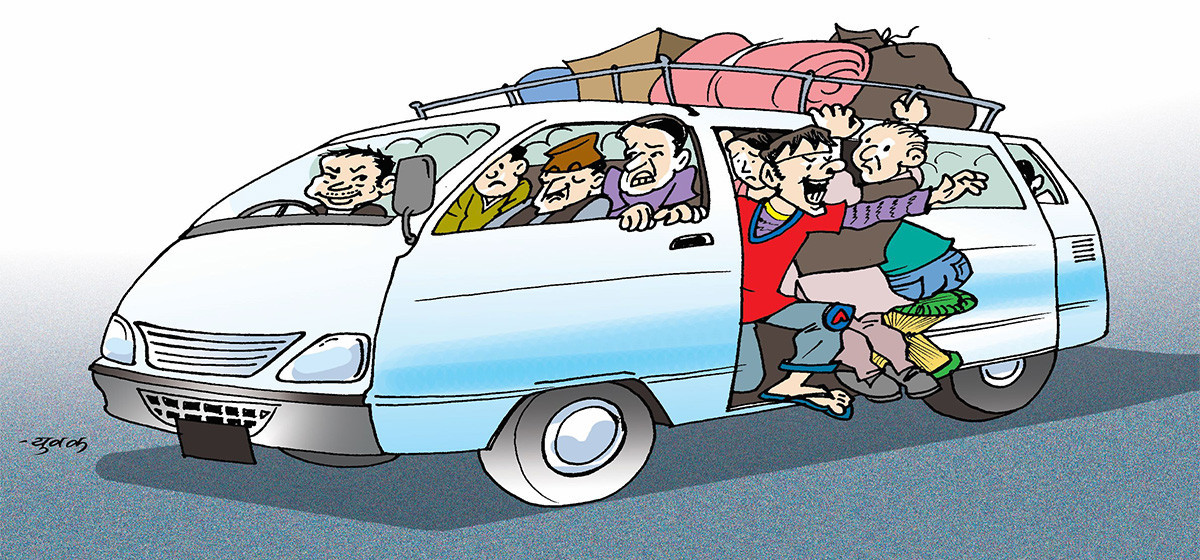KATHMANDU, July 5: First time taking a microbus in Kathmandu? Brace yourself for a ride of a lifetime.
Start with a deep breath
If you're riding a microbus in Kathmandu for the first time, take a deep breath and steel your nerves. You’ll need courage—not just to board the vehicle, but to survive the chaos that comes with it. You might ask, “What sort of courage?” Let’s begin with tolerance—for all kinds of smells, crammed spaces, rude behavior, and the sheer unpredictability of the journey.
These aren’t just the usual woes of public transport in Nepal; in Kathmandu’s microbuses, they become essential survival skills. Riding a micro here isn't just about getting from one place to another—it's a daily test of patience and resilience, as any regular commuter can attest.
A poor man’s necessity, not a choice
For the working class and lower-middle-income groups, microbuses are often the only affordable mode of transport. Taxis are too expensive, and private vehicles are beyond reach. But while microbuses are cheap, the experience they offer is far from comfortable.
Daily commuters deal with packed vehicles, long traffic jams, dust, pollution, and often rude staff. What should be a 20-minute ride from New Bus Park to Ratna Park during off-peak hours can stretch beyond an hour during rush hour. Packed like sardines, many passengers have to travel standing, or worse—dangling from the doorway.
Hoping for a seat on a microbus is like trying to buy a plane ticket during the festive season. Unlike festive flights, however, microbus travel is a daily ordeal.
Sajha Yatayat brings 20 more new city buses

Overload and verbal abuse
Drivers and conductors keep shouting "Come on in!" even as passengers are already crammed beyond capacity. Passengers respond in frustration: “There’s no seat, we’re stuck at the door, and still it’s overloaded!” In return, the staff often respond rudely or dismissively. Expecting professionalism is foolish when the goal seems to be breaking every traffic rule possible.
And then there’s the road. Kathmandu’s streets are in shambles. Traffic jams are so common they feel like permanent features. Sometimes, it feels like using public transport in this city is more of a punishment than a right.
A season of suffering
During the hot and rainy seasons, traveling by microbus is a misery that words can barely capture. The buses have no fans, let alone AC, and passengers swelter in the heat. Sweat pours, odors intensify, and if you’re unlucky enough to sit beside someone who hasn’t bathed, the ride becomes unbearable. In short, prepare for a “nasal war” before boarding.
Then the rains come. The windows don’t close properly, and the roofs leak. Water pours inside, drenching passengers. On such days, a microbus ride feels like a pre-visit to hell.
Not public transport? Nah, public torment
Kathmandu’s microbuses cannot be classified as proper public transportation. They are more aptly described as “public punishment vehicles.” In a 16-seater bus, over 40 people might be jammed in, with the conductor yelling, “Move to the back!” But where exactly is the back? There's no space, and pushing causes scuffles among passengers.
Struggles spike for women
Around the world, women are raising their voices against harassment. Nepali women are doing the same—but in the cramped spaces of Kathmandu’s microbuses, the fight has already been lost. Here, gropers and predators blend easily into the crowd. Rude comments and unwanted touches are everyday realities for women commuters.
Even drivers and conductors are sometimes verbally abusive. These incidents are common, yet complaints are rare. Many educated women in the capital remain silent, choosing to avoid confrontation rather than report abuse via traffic apps, police, or social media.
Even discounts have a deadline
The government mandates a 45% discount on public transportation fares for students, senior citizens, and people with disabilities. But as evening approaches, microbus staff begin declaring, “No discounts after dark!”—a signal that overcharging is about to begin.
Most passengers are too timid to protest. Those who do may find themselves embroiled in unnecessary conflict. There is no official regulation ending the discount at night, yet transport operators ignore the law without consequence.
Evening hours are critical: schools, colleges, coaching centers, libraries—all run late into the evening. Many people must travel at night, but transport operators clearly couldn’t care less.
A rupee here, a scam there
Fares are typically posted inside the vehicle. Suppose the fare is listed as Rs. 19. You hand over Rs. 20—understandable, no one has small change. But if you pay Rs. 26, don’t expect Rs. 1 or 2 back. Conductors will demand Rs. 30, saying they have no change.
Ask for your change, and you risk being yelled at. Don’t ask, and you become one of the hundreds of passengers quietly cheated each day. Four rupees might not seem much, but scale that across 100 passengers, and one microbus could be skimming Rs. 400 a day. Multiply that across Kathmandu’s entire fleet, and you’re looking at a massive daily scam. What else can we call this but public looting?
“Where is Balen?”
There’s a trend among travelers—anywhere in the Valley becomes “Balen’s city” on social media. Whether you’re in Kathmandu, Bhaktapur, or Lalitpur, it’s all under the aura of Balen Shah, the Mayor of Kathmandu.
But when it comes to the suffering caused by microbuses, Balen seems absent. Not just him—federal, provincial, and local governments have all turned a blind eye.
Balen once campaigned with promises of “smart buses.” But now, no one asks what became of that plan. Not even his most devoted supporters bring it up. The promise remains buried in paperwork, while private microbus operators continue to fleece citizens—often with Balen’s photo plastered on their windshields.
In plain terms, the mayor’s metaphorical stick isn’t being used against lawless transport operators, but rather seems to fall on helpless passengers.
Where are the traffic police?
In this circus of suffering, traffic police appear to be silent spectators. Their primary function seems to be standing by the roadside, doing little.
Stories of weekly extortion by the traffic police and Home Ministry officials from transport operators are already common. Perhaps this negligence is just a byproduct of that deeper corruption.
Yet when it comes to private vehicles, traffic police suddenly become hyperactive—lying in wait, setting traps, issuing fines, or collecting small bribes. This growing reputation is now a frequent complaint among Kathmandu’s private vehicle owners.









-1200x560_20230318142551.jpg)


























